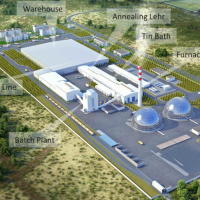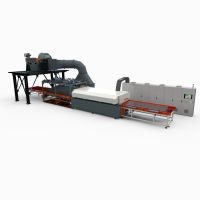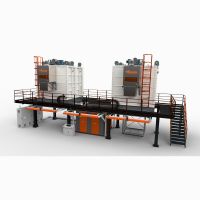Author: Antti Aronen | Glaston
Source: glastory.net
Achieving efficient tempering without compromising on quality is a challenge in the dynamic landscape of glass manufacturing with its multitude of glass sizes, coatings and paints. For years, operators have been the ones responsible for selecting the best recipe from a vast array of options. Yet, as technology advances, can human expertise match the efficacy of machine learning and AI-driven solutions? The latest developments allow us to shift process control from manual settings to precise specifications. In this article, we explore the transformative potential of automated glass tempering.
Tempered glass production is not just about making good-quality glass. The process involves meeting a host of essential requirements driven by regional or factory standards, factory targets or end-user demands. These might include achieving a high production rate, increasing yield, minimizing anisotropy levels, reducing deformations or much more.
Operators may find it extremely difficult to strike a perfect balance between all of these targets. Moreover, how they choose to achieve this is completely up to them and can vary significantly.
Human factor affects the outcomes
There are numerous ways to run the process. For optimal quality, different loading profiles and sizes need different settings. From tens of various parameters available in the user interface, the operator alone chooses the settings. And almost always, this choice is based on experience rather than science.
Especially today, it is increasingly difficult to hire and keep talented operators. As a result, they often become the limiting factor for machine performance. Almost without exception, a machine has the potential to produce higher quality with greater capacity.
In addition, decision-making is based on different human logic across the separate shifts. If more than one operator operates the line, this can lead to process inconsistencies. Without using the same processing rules consistently, uniform quality is next to impossible to achieve.
Key in automating the process
Automating the tempering process can solve these challenges. A centralized process model known as the Tempering Process Autopilot has been developed for control.
This automation-based model provides a platform for adjusting the process to take into consideration any desired product specifications and factory requirements. Basically, it makes the tempering machine responsible for recommending the loading pattern and setting process parameters to meet the targets.
In essence, Autopilot minimizes the operator’s role in glass tempering. It applies consistent tempering rules and maintains repeatability, regardless of the operator in charge of the process.
Further developments based on information
The more collective process measurements there are, the higher the overall level of automation. Autopilot helps to adjust tempering parameters more accurately, depending on the internal and external variables.
The benefits of automating the glass tempering process are evident: more streamlined, efficient and consistent production.
Still, Autopilot does not eliminate the operator completely. While it does minimize the human role in processing conventional glass products, operators can focus instead on more complex tempering processes, taking new products into production.
After all, it’s the cutting-edge synergy between human ingenuity and technological power that propels the industry forward.
For more information on this disruptive technology, be sure to check out this presentation first shared at GPD 2023.






















Comments
The tempering machine can now take on more responsibility with its ability to recommend the optimal loading pattern and set process parameters to meet various targets. This feature streamlines the process and ensures greater efficiency.
Great insights into the transformative potential of automated glass tempering, Antti Aronen! Your analysis highlights the challenges faced by operators in achieving efficient tempering while maintaining quality. The shift from manual settings to precise specifications using machine learning and AI-driven solutions is indeed promising. The Tempering Process Autopilot appears to be a key player in streamlining the process, reducing the human factor's impact, and ensuring consistent, efficient production.
On a side note, this automation-driven efficiency reminds me of the precision required in tasks like gravel driveway installation. It's fascinating to see how technology is enhancing various industries. Exciting to explore more on this disruptive technology, especially the presentation shared at GPD 2023!
In reply to Great insights into the… by Patrick Laurence
What about the impact on employment. as automation may lead to job loss or decreased demand for human labor? How would you address concerns about the cost of implementing and maintaining automated systems for process control?
The article highlights the challenges faced by operators in the glass tempering industry and discusses the potential benefits of incorporating machine learning and AI-driven solutions into the process. Port Chester pool builder
This article made me widen my perspective on the art of making glass.
Residential Dumpster Rental wants to know more about this.
With automation technologies like the Tempering Process Autopilot, glass manufacturers can standardize processes, leading to improved quality and efficiency. This shift allows machines to take on the heavy lifting of setting parameters based on consistent data rather than subjective human judgment. While this doesn't eliminate the need for operators, it does allow them to focus on more intricate tasks that require their expertise. By leveraging technology, the industry can achieve a balance between human insight and automated precision, ultimately driving better outcomes.
Justin@Sydney kitchen renovation